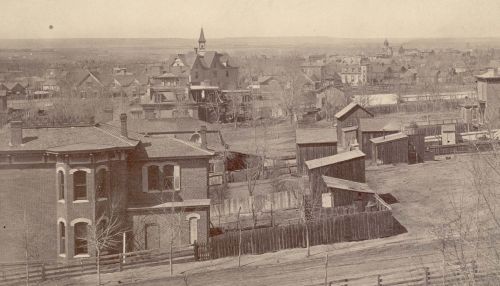Denver, Colorado’s Five Points community originated in the 1880s as an upper middle-class neighborhood for professional and business men. The city built one of its first cable streetcar lines into the area and numerous neighborhood businesses emerged along its tracks. White residents initially occupied the area, but a few prosperous African American families began moving in around the turn of the century.
A major influx of black residents came between 1911 and 1929 when housing developments sprang up elsewhere in the city. These new homes with their modern conveniences such as electrical wiring, plumbing, and garages, attracted many away from older neighborhoods. About the same time, the city extended Broadway, a major north-south artery, through older black neighborhoods. These two factors provided both the impetus and the opportunity for a population shift. Five Points soon became the focal point of activities in a community of nearly 6,000 African American residents.
Black doctors, lawyers, dentists, clergy, railroad porters, as well as cooks, janitors, domestic servants, and other service workers all made their homes in Five Points, attending its many churches, patronizing black businesses, supporting three newspapers, a YMCA and YWCA, baseball clubs, and social activities of all kinds. Five Points residents wanted for little other than the opportunity to move into other neighborhoods or into higher economic brackets through education and jobs.
Although Five Points was one of the most prosperous black communities in the West, the city’s de facto segregation and obvious racial discrimination were on the minds of many. The post-World War II years saw increasing activism as returning servicemen expressed the belief that their service to the nation had earned them the same rights as other citizens. Further, the influx of black families to the city from other states challenged beliefs of long-time black residents, who thought that because they did not suffer the same indignities as African Americans in the southern states, they had little to complain about. In 1961 citizens who disagreed founded a Denver chapter of the Congress on Racial Equality (CORE). They agitated for equal opportunities in jobs, housing, and education. They protested unjust treatment by law enforcement officers and the legal system. Their efforts opened new doors and many black residents left Five Points, causing the area to deteriorate. Older homes began to fall apart, businesses closed, crime and violence rose. By the late 1970s its reputation as a dangerous neighborhood was well established.
Today, many recognize the neighborhood’s important history, and efforts to renew and revitalize the neighborhood have begun to pay off. Five Points received an historic district designation and important buildings along Welton Street have received state preservation money for restoration. Two of these buildings, the Rossonian Hotel and Benny Hooper’s Casino, played vital roles as gathering places for jazz aficionados. Famous black jazz musicians visiting Denver may have played white venues, but the musicians had nowhere to stay other than Five Points, which became well-known for its after-hours jazz scene. The Black American West Museum, founded by Paul Stewart in 1966, occupies the former home of the community’s beloved black doctor, Justina Ford. The Blair-Caldwell Library, named in honor of Tuskegee airman Omar Blair and Denver politician Elvin Caldwell, houses a growing collection of research materials related to African Americans in the west. City leaders and planners along with preservationists are all working to restore the neighborhood’s former dignity and recognize its significant role in the life of the city.


